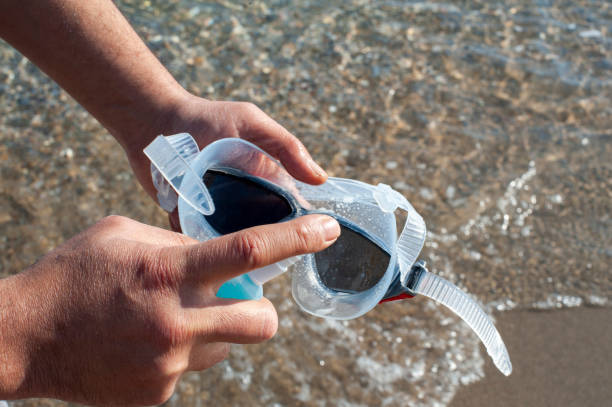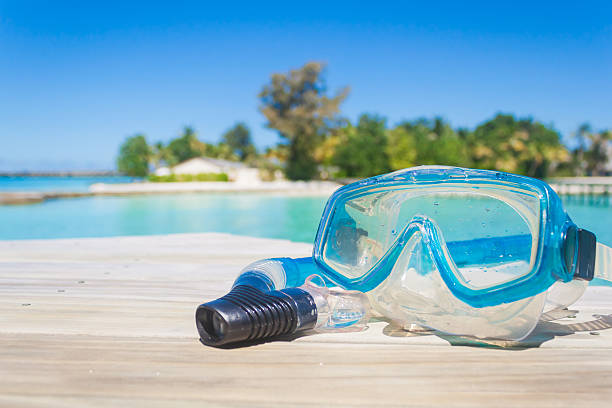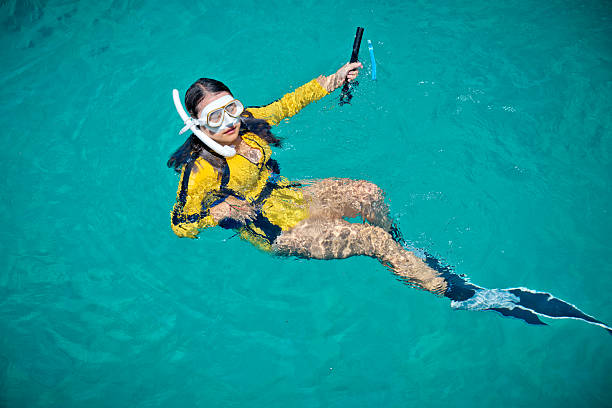Океан является домом для удивительного разнообразия морской жизни: от крошечных морских коньков до величественных морских черепах. Снорклинг, дайвинг с аквалангом и фридайвинг дают возможность встретиться с этими существами вблизи, помогая глубоко оценить хрупкий баланс морских экосистем. Каждое погружение – это возможность увидеть чудеса природы своими глазами. Скользя по кристально чистой воде или погружаясь в глубину на одном дыхании, снорклеры и дайверы наслаждаются захватывающим дух исследованием неизведанных подводных пространств. Чтобы подробнее узнать о различиях между сноркелингом, дайвингом с аквалангом и фридайвингом, в этой статье мы расскажем об их особенностях, глубине погружения и многом другом. Давайте погрузимся в подводный мир!
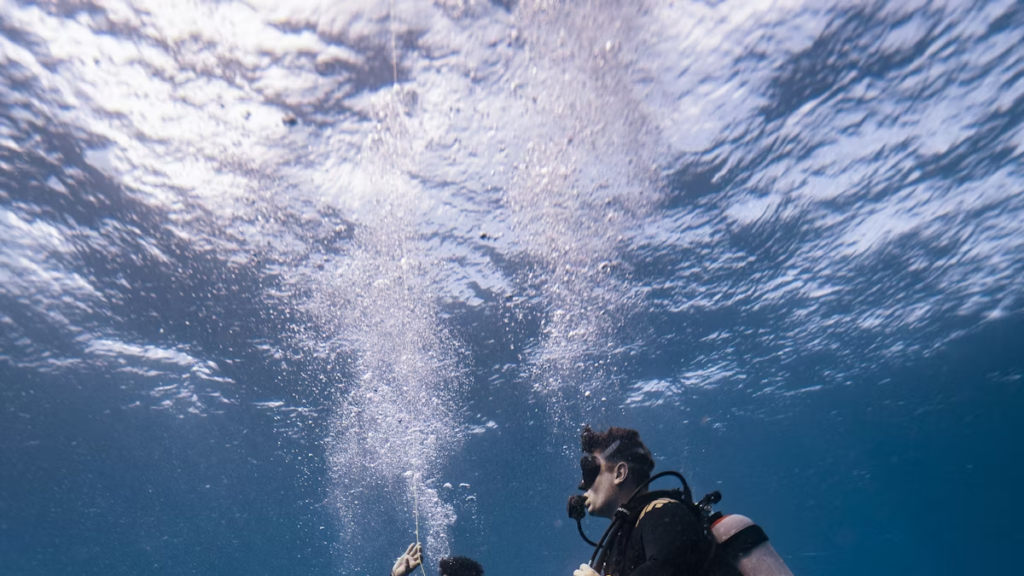
Что такое снорклинг?
Снорклинг — популярный вид водного спорта, позволяющий исследовать подводный мир без необходимости серьёзной подготовки или специального снаряжения. Снорклинг подразумевает плавание на поверхности воды с трубкой для дыхания и ластами для движения. Этот доступный вид подводного плавания подходит людям всех возрастов и уровней подготовки, что делает его популярным выбором для отдыха и приключений.
Преимущества подводного плавания
- Физическая активность: Сноркелинг — это отличная тренировка с низкой ударной нагрузкой, задействующая различные группы мышц и улучшающая здоровье сердечно-сосудистой системы.
- Доступность: В отличие от подводного плавания с аквалангом, сноркелинг не требует серьезной подготовки или сертификации, что делает его доступным для широкого круга любителей.
- Для всей семьи: это занятие, которым могут заниматься все семьи, поскольку оно требует минимального оборудования и навыков.
- Экономически эффективно: По сравнению с другими видами дайвинга, снорклинг относительно доступен, поскольку требует минимального снаряжения.
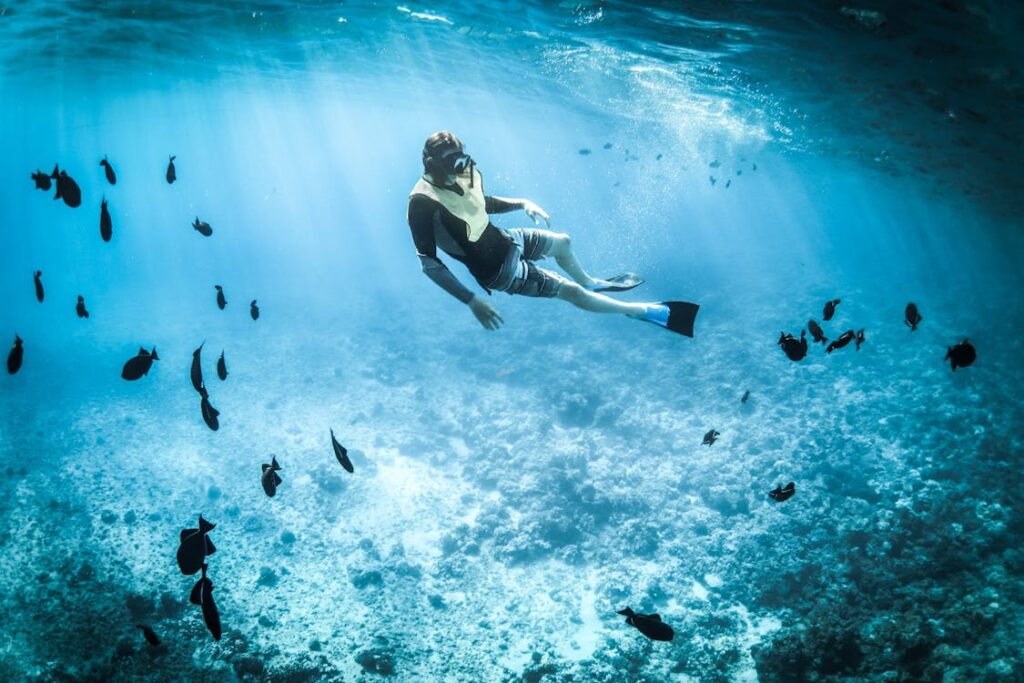
Насколько глубоко могут погружаться дайверы с маской и трубкой?
Дайверы, занимающиеся сноркелингом, обычно ограничены глубиной от 9 до 3 метров. Эта небольшая глубина позволяет любителям наблюдать за яркой морской жизнью и потрясающими подводными пейзажами, оставаясь близко к поверхности воды. Ограниченная глубина позволяет легко подниматься на поверхность для дыхания без необходимости специальной подготовки или использования специального оборудования.
Советы по увеличению глубины погружения с маской и трубкой
Хотя любители подводного плавания с маской и трубкой обычно ограничены мелководьем, существуют стратегии, позволяющие максимально расширить диапазон глубины:
- Обтекаемые движения: Эффективные методы плавания могут помочь уменьшить сопротивление и усилить тягу, позволяя дайверам покрывать большие расстояния, экономя при этом энергию.
- Правильный контроль плавучести: Освоение навыков контроля плавучести позволяет подводникам сохранять удобное положение в воде, что обеспечивает более плавные движения и экономию энергии во время исследования глубин.
- Техники чистого дыхания: Практика спокойного дыхания с трубкой обеспечивает эффективный воздухообмен и способствует спокойствию во время подводных экскурсий.
- Оптимальное использование оборудования: Использование правильно подобранных ласт, обеспечивающих достаточную тягу, может повысить маневренность на мелководье, позволяя дайверам с легкостью ориентироваться.
Какое снаряжение для снорклинга вам понадобится?
При подготовке к подводное плавание с маской и трубкой приключение, имея право снаряжение для подводного плавания Это необходимо для обеспечения безопасного и приятного погружения. Для исследования завораживающего подводного мира любителям снорклинга необходимо следующее снаряжение.
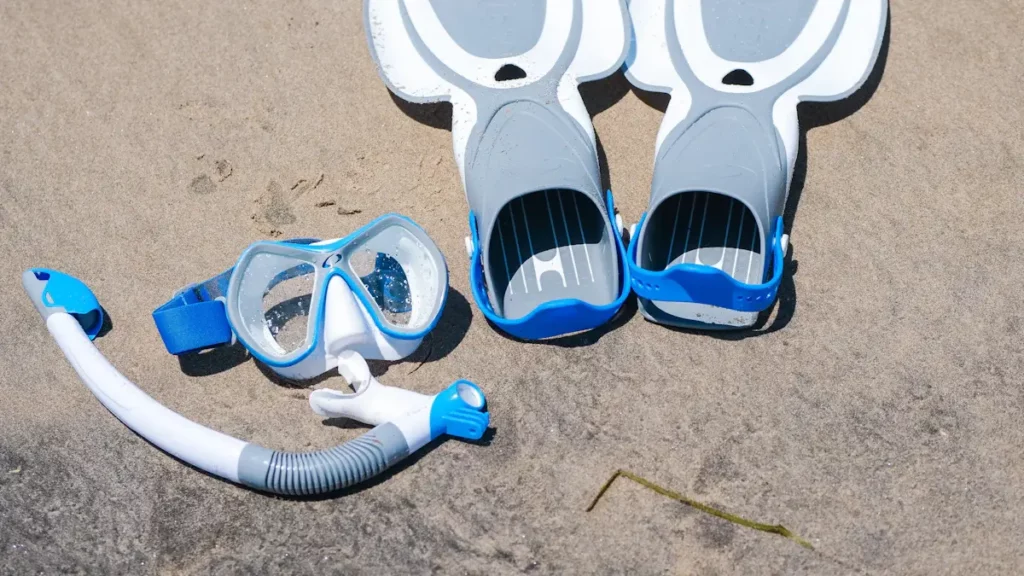
Маска
Высококачественная маска обеспечивает чёткое зрение под водой и комфортную посадку. Маска создаёт воздушный карман вокруг глаз, позволяя ныряльщикам хорошо видеть, не пропуская воду.
Сноркелинг
Трубка — это трубка, позволяющая дышать, плавая лицом вниз на поверхности воды. Обычно она состоит из загубника, трубки и клапана для сброса воды, попавшей в трубку.
Плавники
Ласты необходимы для движения и маневренности в воде, позволяя любителям снорклинга легко ориентироваться и экономить силы во время погружений. Они бывают разных моделей, включая ласты с полной ногой и ласты с регулируемым ремешком.
Гидрокостюм или рашгард
В зависимости от температура воды, одетый в гидрокостюм или рашгард Может обеспечить теплозащиту и защиту от солнца. Гидрокостюм обеспечивает изоляцию, удерживая тонкий слой воды между костюмом и кожей, сохраняя тепло ныряльщиков в прохладной воде. В качестве альтернативы, рашгард обеспечивает защиту от ультрафиолетового излучения и помогает предотвратить натирание кожи при длительном нахождении в соленой воде.
Жилет для сноркелинга
Жилет для снорклинга повышает безопасность, обеспечивая дополнительную плавучесть любителям снорклинга, особенно тем, кто не очень опытен или не уверен в себе. Этот надувной жилет легко регулируется для комфорта и обеспечивает дополнительную поддержку при исследовании мелководья.
Решение для устранения запотевания
А раствор для устранения запотевания нанесенный на внутреннюю поверхность маски, предотвращает запотевание, создавая тонкую пленку, которая равномерно распределяет конденсат по линзе.
Подводная камера (опционально)
Водонепроницаемые камеры, разработанные специально для подводного плавания, позволяют любителям сохранять свои впечатления и делиться ими с другими.
Сетчатый мешок (опционально)
А сетчатая сумка Служит удобным способом транспортировки снаряжения для снорклинга к воде и обратно. Благодаря дышащей конструкции, мокрое снаряжение высыхает естественным образом, предотвращая накопление песка внутри сумки. Кроме того, в сумке предусмотрено место для хранения личных вещей, таких как солнцезащитный крем, солнцезащитные очки и закуски.
Плюсы и минусы снорклинга
Снорклинг обладает множеством преимуществ, делая его привлекательным занятием для тех, кто стремится исследовать подводный мир. Однако, как и любое развлечение, он имеет и определённые недостатки, которые следует учитывать любителям. Понимание плюсов и минусов снорклинга поможет принять взвешенное решение об участии в этом захватывающем опыте.
Плюсы снорклинга
1. Доступность для всех уровней подготовки
Снорклинг доступен для людей любого возраста и уровня подготовки, требуя минимальной подготовки или сертификации. Благодаря своей инклюзивности, он идеально подходит как для семей, так и для новичков и опытных любителей, способствуя развитию чувства совместного исследования и приключения.
2. Захватывающие встречи с морской жизнью
Любители подводного плавания могут полюбоваться завораживающими подводными пейзажами — от ярких коралловых образований до стай тропических рыб, которые открывают для себя замысловатые экосистемы, процветающие под водами.
3. Физическая активность с низкой ударной нагрузкой
Сноркелинг — это низкоинтенсивная физическая активность, которая способствует здоровью сердечно-сосудистой системы и укреплению различных групп мышц. Плавное движение, достигаемое за счёт движений ласт, обеспечивает приятную тренировку, минимизируя нагрузку на суставы и мышцы.
4. Экономически эффективная разведка
По сравнению с другими видами дайвинга, снорклинг относительно доступен, поскольку требует минимального снаряжения и не требует расходов на сертификацию дайвера или специальное оборудование. Эта экономическая эффективность делает его привлекательным вариантом для тех, кто ищет бюджетные водные приключения.
5. Неспешные развлечения
Снорклинг позволяет участникам неспешно исследовать мелководье в удобном для них темпе, давая достаточно времени для наблюдений, фотосъемки и отдыха на фоне захватывающих дух морских пейзажей. Неторопливый характер снорклинга способствует ощущению спокойствия и осознанности во время подводных экскурсий.
Минусы снорклинга
1. Ограниченная глубина исследования
В отличие от подводного плавания с аквалангом или фридайвинга, снорклинг ограничивает участников погружениями на небольшой глубине из-за ограничений, связанных с оборудованием и дыханием, связанными с использованием трубки. Это ограничение может затруднить доступ к более глубоким морским пространствам и некоторым подводным объектам.
2. Зависимость от состояния поверхности
Качество снорклинга зависит от таких условий на поверхности, как прозрачность воды, видимость и погодные условия. Неблагоприятные условия, такие как сильное волнение или плохая видимость, могут повлиять на общее удовольствие от занятий и их безопасность.
3. Экологическая чувствительность
Ответственное отношение к окружающей среде имеет первостепенное значение во время занятий сноркелингом, чтобы минимизировать воздействие на хрупкие морские экосистемы и бережно относиться к среде обитания диких животных. Соблюдение этических норм может потребовать от участников осознанных усилий во время подводных исследований.
Что такое подводное плавание?
Подводное плавание с аквалангом, также известное как фридайвинг, — это вид подводного плавания, при котором дайвер плавает под водой без использования акваланга или дыхательного аппарата. Аквалангисты задерживают дыхание, чтобы погрузиться и исследовать подводный мир. Этот вид дайвинга часто используется для отдыха, подводной охоты или подводной фотосъемки. Аквадайвинг позволяет дайверам приблизиться к морским обитателям и исследовать красоту подводного мира более естественно и незаметно. Для обеспечения безопасного и приятного опыта необходимы хорошие навыки плавания, контроль дыхания и знание техники безопасности.

Насколько глубоко могут погружаться дайверы?
Аквалангисты обладают замечательной способностью погружаться на глубину от от 16 до 131 футов, в зависимости от их подготовки, опыта и физиологических возможностей. Этот расширенный диапазон позволяет более обширно исследовать морскую среду и знакомиться с разнообразными водными формами жизни.
Факторы, влияющие на глубину
Несколько факторов влияют как глубоководные дайверы могут удобно спуститься:
Физиологические адаптации
Тело человека претерпевает физиологические изменения в ответ на погружение в воду, что позволяет дайверам выдерживать повышенное давление на больших глубинах. Эти изменения включают: брадикардия (замедление частоты сердечных сокращений), периферическая вазоконстрикция (сужение кровеносных сосудов) и усиление механизмов сохранения кислорода, поддерживающих длительную задержку дыхания.
Обучение и опыт
Профессиональное владение подводным плаванием требует специальной подготовки по технике задержки дыхания, методам выравнивания давления и правилам безопасности. Опытные подводные ныряльщики развивают повышенный объём лёгких, эффективное использование кислорода и психологическую устойчивость, необходимые для погружения на значительные глубины без использования дыхательных аппаратов.
Расширенные возможности снаряжения
Производители внедрили инновационные разработки в снаряжение для фридайвинга, такие как маски малого объёма, предназначенные для улучшенного выравнивания давления на глубине, ласты с длинными лопастями, оптимизированные для эффективного продвижения, и обтекаемые трубки, минимизирующие сопротивление при погружении. Эти усовершенствования специально разработаны для дайверов, стремящихся к повышению эффективности и комфорту во время подводных погружений.
Управление кислородом
Контроль уровня кислорода становится всё более важным на больших глубинах, где требуется длительная задержка дыхания. Аквалангистам необходимо выработать точный контроль дыхания, сохраняя при этом запасы кислорода для безопасного подъёма на поверхность.
Какое снаряжение для дайвинга необходимо?
Помимо маски, ласт, трубки и купальникаДля безопасного и приятного подводного плавания требуется другое подходящее снаряжение. Снаряжение, необходимое для подводного плавания с аквалангом, позволяет любителям легко и эффективно исследовать завораживающие глубины океана.
Пояс для утяжелителей
Для опытных дайверов, ищущих нейтральную плавучесть на разных глубинах, пояс для утяжеления Может использоваться для точного контроля уровня плавучести. Этот регулируемый пояс позволяет точно регулировать плавучесть в зависимости от изменений глубины во время подводных исследований.
Часы для дайвинга или подводный компьютер
Надежный часы для дайвинга или компьютер для дайвинга Служит важным инструментом для контроля времени погружения, отслеживания профилей глубины и обеспечения соблюдения ограничений безопасности во время занятий дайвингом. Эти устройства предоставляют ценные данные, которые повышают осведомленность о безопасности и помогают эффективно планировать подводные экскурсии.
Плюсы и минусы подводного плавания
Как и любой другой вид активного отдыха, подводное плавание с аквалангом имеет свои преимущества и соображения, которые следует учитывать при рассмотрении возможности участия в этой форме подводного исследования.
Преимущества подводного плавания
1. Расширенная разведка
Возможность погружений на большую глубину отличает дайвинг от снорклинга, позволяя любителям исследовать более широкий спектр подводного мира. От причудливых скальных образований до разнообразных водных биотопов, процветающих на больших глубинах, дайверы могут открыть для себя завораживающие пейзажи, которые могут быть недоступны с поверхности воды.
2. Физическая выносливость
Занятия подводным плаванием требуют от человека развития способности задерживать дыхание и физической выносливости, необходимых для погружения на значительные глубины без использования дыхательных аппаратов. Это способствует общей физической форме и психологической устойчивости, увеличивая объём лёгких и активизируя механизмы сохранения кислорода, необходимые для длительной задержки дыхания.
Минусы подводного плавания
1. Испытания на задержку дыхания
Задержка дыхания при погружении неизбежно создаёт трудности, связанные с контролем уровня кислорода, объёмом лёгких и физиологическими ограничениями, которые необходимо тщательно учитывать при занятиях дайвингом. Контроль уровня кислорода становится всё более важным на больших глубинах, где требуется длительная задержка дыхания.
2. Требования к обучению
Достижение мастерства в подводном плавании с аквалангом требует обучения правильной технике дыхания, методам выравнивания давления, правилам безопасности и физиологическому восприятию — процесс, требующий от участников самоотдачи и самоотдачи. Освоение эффективных методов выравнивания давления крайне важно для предотвращения дискомфорта и потенциальных травм, связанных с перепадами давления воды на разных глубинах.
Что такое фридайвинг?
Фридайвинг, также известный как погружение на задержке дыхания, — это вид подводного плавания, основанный на задержке дыхания без использования акваланга или другого дыхательного аппарата. Это популярный вид отдыха и соревновательный вид спорта, включающий погружения на различную глубину и продолжительность на одном вдохе воздуха. Фридайверы часто тренируются, чтобы улучшить способность задерживать дыхание, техники релаксации и навыки дайвинга, позволяющие им погружаться дольше и на большую глубину. Фридайвинг позволяет дайверам исследовать подводный мир более естественно и глубоко, погружаясь с морской средой без шума и оборудования, характерных для подводного плавания с аквалангом.
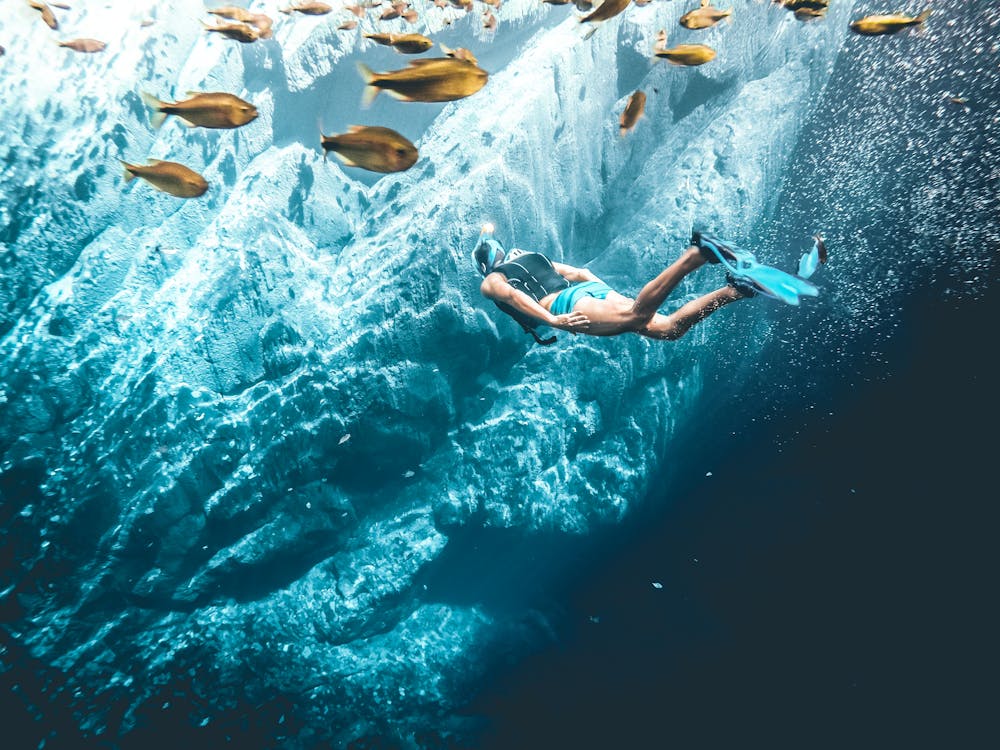
Дисциплины фридайвинга
Фридайвинг охватывает различные дисциплины, ориентированные на разные цели и глубину погружения:
- Фридайвинг с постоянным весом: В этой дисциплине дайверы погружаются и поднимаются, используя свою силу, без помощи грузов или ласт.
- Свободное погружение Фридайвинг: Любители подводного плавания подтягиваются по вертикальной линии во время спусков и подъемов, не полагаясь на ласты.
- Фридайвинг с переменным весом: Эта дисциплина позволяет дайверам использовать утяжеленные сани для спуска и подъема, используя при этом силу своего движения на протяжении части пути.
- Фридайвинг без ограничений: Водолазы используют утяжеленные сани для быстрого спуска и подъема с помощью надувного подъемного мешка.
Насколько глубоко могут погружаться фридайверы?
Глубинные возможности фридайверы действительно внушают благоговение, позволяя им проникать в подводные миры, начиная от от 16 до 656 футов. Этот замечательный комплекс предоставляет любителям глубин доступ к завораживающим пейзажам и возможность встретиться с разнообразными морскими видами, обитающими на больших глубинах.
Меры безопасности
Ответственные меры безопасности имеют первостепенное значение во фридайвинге из-за присущих ему сложностей, связанных с длительной задержкой дыхания на значительной глубине:
- Система приятелей: Занятия фридайвингом с надежным партнером по дайвингу повышают безопасность, обеспечивая взаимную поддержку во время спусков и подъемов.
- Протоколы безопасности: Строгое соблюдение установленных правил безопасности сводит к минимуму потенциальные риски, связанные с управлением кислородом, трудностями выравнивания давления и физиологическими ограничениями.
- Экологическая осведомленность: Практика ответственного управления окружающей средой имеет решающее значение во время фридайвинг-экскурсий, чтобы свести к минимуму нарушения хрупких морских экосистем на больших глубинах.
Какое снаряжение для дайвинга необходимо?
За последние несколько лет использование снаряжения для фридайвинга постоянно растет, что обусловлено значительными инвестициями в технологические достижения со стороны производителей снаряжения для дайвинга, таких как АвангардЭто свидетельствует о росте технологических достижений в этой области, отражая возросший интерес к техническому дайвингу и фридайвингу. Помимо основного снаряжения, такого как маски, ласты, трубки, гидрокостюмы, грузовые пояса, а также дайверские часы или компьютеры, обычно используемые во фридайвинге, для специализированного фридайвинга обычно требуется:
Маска с малым объемом
Маска малого объема, разработанная специально для фридайвинга, обеспечивает улучшенное выравнивание давления на больших глубинах за счет минимизации объема воздуха внутри маски.
Длиннолопастные ласты
Ласты с длинными лопастями, оптимизированные для эффективного движения вперед, позволяют ныряльщикам покрывать большие расстояния с минимальными усилиями и экономить энергию.
Обтекаемая трубка
Обтекаемая трубка уменьшает сопротивление при погружении в глубокие воды, повышая эффективность задержки дыхания и сводя сопротивление к минимуму.
Буй для фридайвинга
Использование специального буя для фридайвинга позволяет любителям подводного плавания отмечать свое положение на поверхности во время погружений и подъемов, обеспечивая при этом видимость для персонала, обеспечивающего безопасность.
Зажим для носа
Носовой зажим помогает выравнивать давление в носовых проходах при погружении на большую глубину, предотвращая попадание воды, не затрудняя при этом дыхание через рот.
Плюсы и минусы фридайвинга
Как и любая форма подводного плавания, фридайвинг имеет свои преимущества и соображения, которые следует учитывать при рассмотрении возможности заняться этой дисциплиной.
Плюсы фридайвинга
1. Связь с природой
Фридайвинг позволяет дайверам более естественно и глубоко познавать подводный мир, укрепляя их связь с морской жизнью и окружающей средой.
2. Физические и психические преимущества
Фридайвинг развивает физическую форму, контроль дыхания и методы релаксации, увеличивая объем легких и снижая уровень стресса.
3. Экономически эффективное решение
Для фридайвинга требуется минимум снаряжения по сравнению с подводным плаванием, что делает его более доступным вариантом исследования подводного мира.
4. Чувство достижения
Завершение фридайвинга на большую глубину или длительность может подарить чувство выполненного долга и способствовать личностному росту.
Минусы фридайвинга
1. Риск потери электроэнергии
Фридайвинг несет в себе риск гипоксии и потери сознания на мелководье, что может привести к потере сознания под водой.
2. Травмы, связанные с давлением
Фридайверы подвержены баротравме и декомпрессионной болезни при погружениях на значительную глубину без надлежащей подготовки и мер предосторожности.
3. Физические требования
Фридайвинг требует хорошей физической подготовки, умения задерживать дыхание и психологической дисциплины, что может оказаться сложной задачей для некоторых людей.
4. Экологические опасности
Фридайверы должны знать о потенциальных опасностях в подводной среде, таких как встречи с морскими обитателями, сильные течения и меняющиеся условия.
Разница между сноркелингом, дайвингом и фридайвингом
Что касается подводных занятий, то снорклинг, подводное плавание с аквалангом и фридайвинг — каждый из них предлагает уникальные впечатления и имеет существенные различия с точки зрения снаряжения, глубины погружения и техники дыхания.
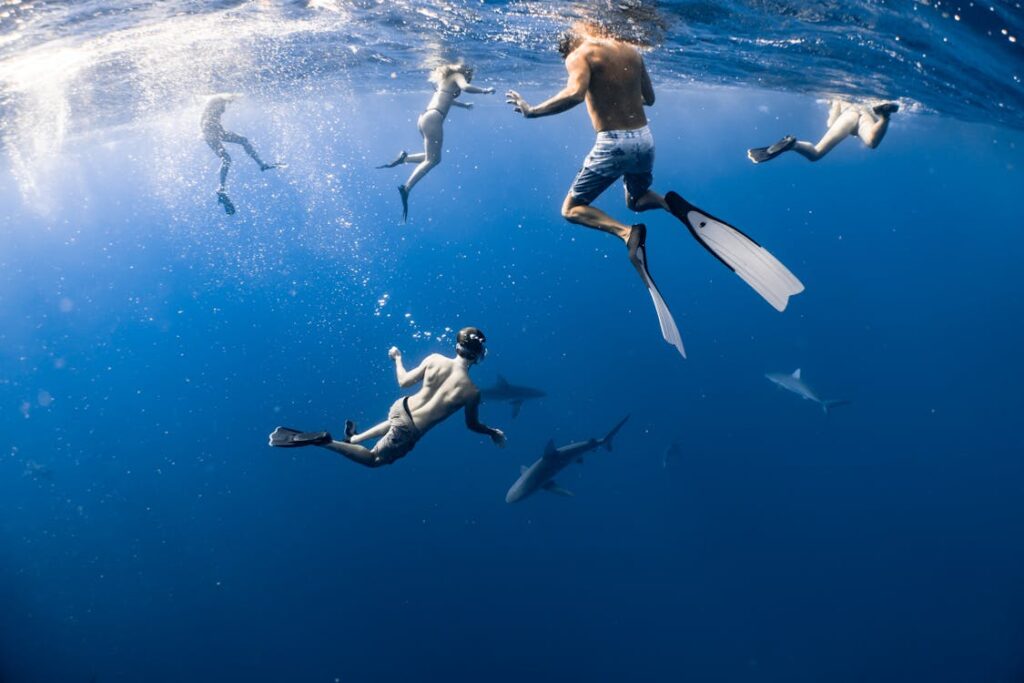
Вариант оборудования
Сноркелинг Обычно требуется минимальное снаряжение, включая маску для ясного зрения под водой, трубку для дыхания на поверхности воды и ласты для движения. Этот доступный вид подводного плавания подходит тем, кто ищет неспешного знакомства с морской жизнью на мелководье.
С другой стороны, подводное плавание с аквалангом Сноркелинг предполагает использование того же снаряжения, что и для плавания с маской и трубкой, но позволяет дайверам погружаться под воду. Любители могут также воспользоваться дополнительным снаряжением, например, гидрокостюмами или гидромайками, чтобы обеспечить термозащиту и контроль плавучести на разных глубинах.
В отличие, фридайвинг Требуется специализированное снаряжение, разработанное для повышения эффективности погружений на больших глубинах. Оно включает в себя маски малого объёма, предназначенные для улучшенного выравнивания давления на глубине, ласты с длинными лопастями, оптимизированные для эффективного продвижения, обтекаемые трубки, минимизирующие сопротивление при погружении, и специальные буи для фридайвинга, отмечающие положение на поверхности во время всплытия.
Возможности глубины и продолжительности
Глубинные возможности этих подводных видов деятельности существенно различаются.
| Активность | Средняя глубина (футы) | Максимальная глубина (футы) | Средняя продолжительность (минуты) | Максимальная продолжительность (минуты) |
| Сноркелинг | 3-10 | 20 | 30-60 | 120 |
| Дайвинг | 16-131 | 150 | 30 | 60 |
| Фридайвинг | 330+ | 330+ | 2-5 | 10+ |
Различия в технике дыхания и снаряжении
Дыхательные техники играют решающую роль в различии этих подводных занятий. Любители подводного плавания полагаться на трубку для эффективное дыхание на поверхности воды легко паря над мелководьем. Использование дыхательной трубки ограничивает глубину, но обеспечивает доступный способ наблюдения за морскими экосистемами без серьёзной подготовки или специального оборудования.
Напротив, оба дайверы и фридайверы Фридайверы используют техники задержки дыхания, позволяющие им погружаться под воду без использования баллонов со сжатым воздухом или дыхательных аппаратов, используемых при подводном плавании с аквалангом. Однако фридайверы проходят интенсивную подготовку по правильной технике дыхания и физиологической адаптации, необходимой для длительной задержки дыхания на значительных глубинах по сравнению с относительно небольшими погружениями аквалангистов.
Заключение
В заключение, хотя снорклинг, дайвинг с аквалангом и фридайвинг предполагают исследование подводного мира, они существенно различаются по технике, оборудованию и глубине погружения. Снорклинг позволяет наблюдать за подводным миром с помощью трубки, дайвинг с аквалангом предполагает неглубокие погружения без дыхательного аппарата, а фридайвинг предполагает более глубокое погружение с помощью техники задержки дыхания. Надеемся, что это исчерпывающее руководство о различиях между снорклингом, дайвингом с аквалангом и фридайвингом поможет любителям выбрать тот вариант, который лучше всего соответствует их предпочтениям и уровню подготовки в подводном мире.
Часто задаваемые вопросы
1. В чем разница между подводным плаванием с аквалангом и сноркелингом?
Снорклинг обычно подразумевает плавание на поверхности воды с дыханием через трубку, что позволяет участникам наблюдать за подводным миром, не ныряя глубоко. В отличие от этого, подводное плавание с аквалангом подразумевает погружение под воду без использования дыхательного аппарата, полагаясь исключительно на задержку дыхания, часто на короткие промежутки времени, для исследования глубинных подводных пространств.
2. В чем разница между сноркелингом и фридайвингом?
Снорклинг и фридайвинг являются водными видами спорта, но они значительно различаются по глубине, продолжительности и используемому оборудованию. Снорклинг подразумевает плавание на поверхности воды с трубкой, позволяя непрерывно дышать и наблюдать за подводным миром. Фридайвинг же, напротив, подразумевает погружение под воду без дыхательного оборудования, предполагающее длительную задержку дыхания для исследования более глубоких глубин. Фридайвинг требует специальной подготовки по технике задержки дыхания и соблюдению правил безопасности, что позволяет дайверам погружаться на большую глубину за более короткое время по сравнению со снорклингом.
3. В чем разница между дайвингом и фридайвингом?
Главное различие между дайвингом и фридайвингом заключается в подходе к исследованию подводного мира и использовании снаряжения. Дайвинг, часто называемый подводным плаванием с аквалангом, подразумевает использование специализированного оборудования, такого как акваланг, регуляторы и устройства контроля плавучести, для дыхания под водой и исследования больших глубин в течение длительного времени. Фридайвинг же, напротив, — это вид подводного плавания, основанный исключительно на технике задержки дыхания, без использования дыхательных аппаратов. Фридайверы погружаются на различные глубины, используя только объём лёгких, что требует специальной подготовки по задержке дыхания и соблюдению правил безопасности.
4. Сложнее ли плавать с маской и трубкой, чем дайвинг?
Снорклинг обычно считается более простым занятием, чем дайвинг, поскольку требует меньше специализированного снаряжения и подготовки. Снорклеры находятся на поверхности воды, дыша через трубку, в то время как дайверы используют акваланг для исследования более глубоких глубин. Дайвинг требует более глубоких технических навыков и знаний по технике безопасности.
5. Используете ли вы трубку во время фридайвинга?
Во фридайвинге трубки обычно используются во время поверхностных погружений для дыхания, пока фридайвер плавает на поверхности воды. Однако, как только фридайвер начинает погружение под воду, он не использует трубку, так как она может создавать ненужное сопротивление и мешать эффективному движению в воде. Вместо этого фридайверы полагаются исключительно на свою способность задерживать дыхание, исследуя подводное пространство.
